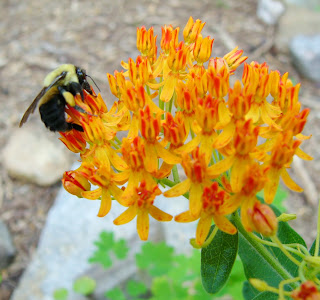Plants that provide food for the butterflies:
Bee-balm (Monarda didyma)
Bee-balm is a strong-scented perennial native to the northeastern United States. They grow 3 to 6 feet tall with a crown-like whorl of showy red flowers 3-4 inches in diameter. Besides being beautiful the leaves can be used as a mint flavoring in cooking or making teas. Find the bee-balm in LRRP butterfly garden. Blooms from July to September.
Joe-Pye Weed (Eupatoriadelphus fistulosus)
Native to eastern North America, this perennial can grow up to 10 feet tall. Joe-Pye Weed flowers from mid-summer and can be found in wet forests or alongside ditches. The Eastern Tiger Swallowtail, Great Spangled Fritillary, Pearl Crescent, Monarch, and the Tawny-edged Skipper are just some of butterflies known to love Joe-Pye.
Coral Honeysuckle (Lonicera sempervirens)
This red-flowering honeysuckle is native to the southeastern U.S. It is drought tolerant and prefers full-sun. These vines attract butterflies, hummingbirds and other pollinators and songbirds enjoy the berries in the fall. Unlike its relative, the Japanese Honeysuckle, this vine will not spread out of control.
Butterfly-weed (Ascelpias tuberosa)
Butterfly-weed also known as chigger-weed or pleurisy-root is a perennial native to much of the eastern United States. Often favored for its striking flowers that are usually orange, but can be yellow or red. Enjoy the butterfly-weed while sitting on the garden bench under the arbor. Blooms from May to August.
Plants that provide food for caterpillars:
Spicebush (Lindera benzion)
Native to eastern U.S., the leaves of this deciduous shrub are a favorite of the spicebush swallowtail. It typically grows 6 to 12 feet high and prefers moist soil with full or partial sun. The thick, oblong-ovate leaves are aromatic when crushed and turn a brilliant yellow in the fall.
Bronze Fennel (Foeniculum vulgare)
Bronze Fennel has stunningly beautiful, purple feathery plumes and a strong licorice scent. Actually a native to Europe, Spanish explorers brought seeds with them to plant in the New World. Bronze fennel grows between 4 – 6 feet tall, prefers full sun and is also drought tolerant. Swallowtail butterflies lay eggs on the foliage and the larvae feed on the leaves.






No comments:
Post a Comment